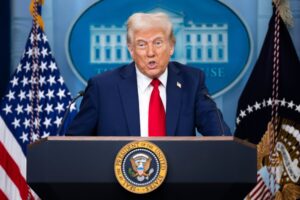
The world economy is on course for its weakest decade of growth since the 1960s, according to a stark warning from the World Bank, which downgraded global forecasts and pointed to mounting turmoil in US trade policy as a key drag on recovery.
In its latest Global Economic Prospects report, the Washington-based lender slashed its 2025 forecast for global GDP growth to 2.3 per cent – down 0.5 percentage points from previous estimates – blaming the disruption caused by the return of aggressive US tariffs and a breakdown in international economic co-operation.
If current trends hold, average global growth for the 2020s would reach just 2.5 per cent — making this the worst-performing decade for the world economy since the 1960s.
The World Bank said Donald Trump’s recent tariff policy and uncertainty around US economic leadership had disrupted the post-pandemic path to a “soft landing”, with nearly three-quarters of all countries seeing their forecasts downgraded this year. The biggest cuts were seen in the US, Thailand and South Africa.
The US economy is expected to slow sharply from 2.8 per cent growth last year to 1.4 per cent in 2025 – a full percentage point downgrade from January. The eurozone was revised down to just 0.7 per cent growth this year, with China also expected to miss its 5 per cent growth target, coming in at 4.5 per cent.
In contrast to more optimistic forecasts from the OECD, which last week projected global growth of 2.9 per cent this year and next, the World Bank took a more pessimistic view of both developed and developing economies.
“Outside of Asia, the developing world is becoming a development-free zone,” said Indermit Gill, the World Bank’s chief economist. “Growth in developing economies has ratcheted down for three decades — from 6 per cent annually in the 2000s, to 5 per cent in the 2010s, to less than 4 per cent in the 2020s.”
The World Bank called for urgent action to reverse a slide into global economic stagnation, including the reduction of trade barriers, renewed investment in productivity, and global co-operation on clean energy and infrastructure.
It said removing current trade tariffs and halving rates compared to their May 2025 levels could boost global growth by 0.2 percentage points annually over the next two years.
The report also noted the shifting political dynamics in Washington, with the Trump administration’s influence increasingly felt through its scepticism of multilateral institutions like the World Bank and the IMF. In response to pressure from the White House, the World Bank is preparing to lift its longstanding ban on nuclear energy project funding — a sign of its willingness to accommodate US interests.
Yet the broader message from the institution was one of concern. “The world economy has not only failed to rebound from the shocks of the pandemic and energy crises,” the report concluded, “but it is at risk of settling into a new normal of persistent underperformance unless co-ordinated action is taken.”
The warning is likely to sharpen calls for clarity on trade policy from the US and stronger commitments from global leaders ahead of the next G7 and G20 summits.
With the US election looming and markets on edge over geopolitical tensions, the World Bank’s report serves as a sobering reminder that global economic stability is far from assured.
Read more:
Global economy faces bleak outlook as World Bank warns of worst decade since 1960s





